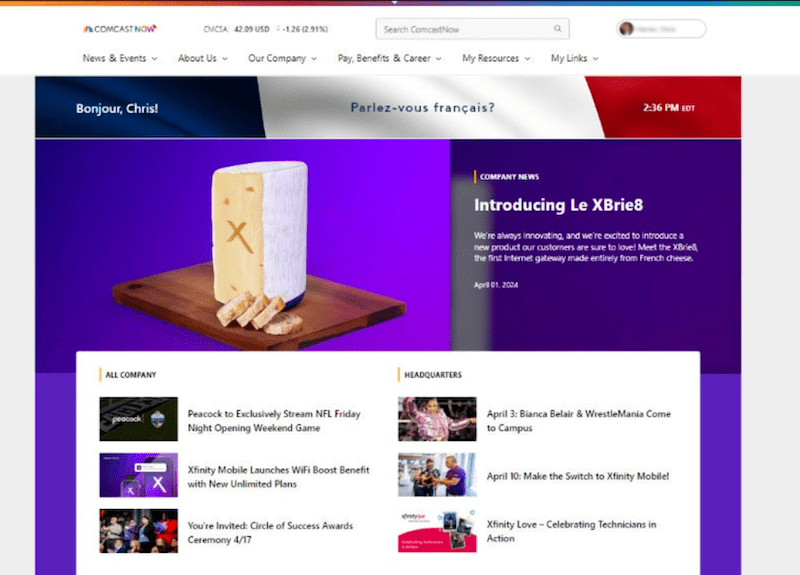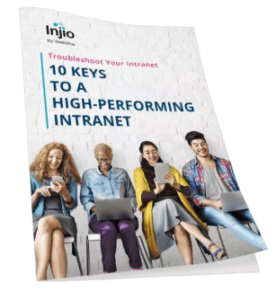Last week, I had the opportunity to attend the Step Two DEX (Digital Employee Experience) conference in Sydney, a day filled with insightful discussions on the future of intranets and digital workplaces. The conference brought together thought leaders and practitioners to share their experiences and strategies for enhancing employee engagement through innovative technologies and methodologies.
Here are some key highlights and reflections from the event.
1) ROI of Personalised Digital Workplaces
 Chris Harrer opened the conference with a compelling case for investing in personalised digital workplaces at Comcast. He emphasised how tailored digital environments – particularly with helpful integrations – can significantly enhance employee satisfaction and productivity.
Chris Harrer opened the conference with a compelling case for investing in personalised digital workplaces at Comcast. He emphasised how tailored digital environments – particularly with helpful integrations – can significantly enhance employee satisfaction and productivity.
Particularly interesting were the success of introducing a long home page to enhance user engagement, especially on mobile, and leveraging a multichannel approach to make the intranet accessible via desktop, mobile, and Teams. Their “My Resources” page, with a comprehensive searchable list of tools, is also very popular. This was of course a highly resourced endeavour for a huge company with an internal team of 3, plus internal IT and external consultants. If you don’t have this kind of funding, choose an intranet accelerator like Injio, and add enhancements over time.
2) Change Management Strategies
Ian Ragsdale shared insights on change management, drawing from his extensive experience at Visa and Whole Foods. His strategies highlighted the importance of clear communication and employee involvement during transitions, ensuring that teams feel supported and engaged throughout the process.

3) The Evolving Role of AI
Deborah Hook at the University of Sydney and Jenny Nguyen from Telstra delved into the transformative role of artificial intelligence (AI) in modern workplaces. They discussed how AI can be effectively implemented in complex environments while addressing governance challenges. USyd decided to apply these to their policy library and created a Copilot-like front end where people could ask questions. The main lesson learned? AI is not a set and forget technology – it requires ongoing management and correction, with direct links to content also helpful for verification. When they started, the AI tool answered 60% of questions right the first time. It took a year to get to 90%. It is harder than you think!
Their perspectives underscored AI’s potential to streamline operations and enhance decision-making processes and with Clearbox also focusing on AI lately, there’s a lot of industry attention on this area.
4) Innovative Onboarding Practices
 Dinar Thalieb provided a behind-the-scenes look at employee onboarding at Canva.
Dinar Thalieb provided a behind-the-scenes look at employee onboarding at Canva.
The business benefits Canva believes come from a high-quality onboarding experience are:
- Retains people longer, because they feel that the company has invested in their growth.
- Time to impact is shortened.
- Sustained high performance and engagement.
Her presentation illustrated how Canva leverages technology to create an engaging onboarding experience, ensuring new hires feel welcomed and equipped to succeed from day one. Their solution features a “Newbie Hub”, which is a microsite, tailored to the region or location where the new employee will be working. There is an emphasis on it being self-service driven.
They back this up with information on their intranet which explains all the milestones in their onboarding process and automated messaging, which includes pre-boarding and communications to their manager and buddy to set expectations.
Canva believe we are all focusing too much on week one, when the new hire needs different kinds of support for a much longer period. Canva’s onboarding process goes for three months.
5) Engaging Frontline Employees
Jeremy Bowell presented powerful case studies focused on engaging frontline employees. He emphasised that effective communication and recognition are crucial for fostering a motivated workforce, particularly in roles that often feel disconnected from corporate strategies. James Robertson of Step Two suggested enterprise social platforms such as Viva Engage are particularly beneficial for front line employees as they are typically engaging via a mobile phone and can quickly upload photos and videos. (see below)
6) Successful Intranet Migrations
Victorin Lai impressed attendees with her successful intranet migration project, merging three separate platforms into one cohesive system within just six months. This case study highlighted best practices for intranet migrations, as discussed by James Barnett, who shared insights on ensuring user adoption and minimising disruption during transitions.
7) Focus on Work Processes
Domino Risch of Placeology highlighted some interesting statistics about the spectrum of hybrid/remote work with only 11% of us in the office full time, and 74% of us working in either structured hybrid or fully flexible work arrangements. She reminded us of the importance of focusing on how we work rather than just where we work, in the face of recent, very public RTO mandates. It’s also a perspective that is essential for designing digital workplaces that truly meet employee needs and facilitate collaboration.

8) Enterprise Social Platforms
James Robertson closed the day with a compelling argument for engaging with strong enterprise social platforms. He highlighted how these tools can foster community and collaboration among employees, ultimately enhancing the overall employee experience.
Key Reflections
Reflecting on the conference, several themes emerged that are pivotal in shaping the future of digital workplaces:
- SharePoint Dominance: Nearly all showcased intranets were built on SharePoint, underscoring its popularity as a platform for creating dynamic digital workplaces.
- AI’s Transformative Potential: AI is set to revolutionise knowledge management by enhancing information retrieval and user experience. However, significant investment is still required to bridge gaps in usability and functionality.
- Engagement Challenges: Engaging employees remains a universal challenge across organisations. A well-researched, strategic approach is critical for fostering an environment where employees feel valued and connected.
- Intranet Naming Trends: The terms “hub” or “portal” continue to dominate intranet naming conventions. This presents an opportunity for organisations to rethink their branding strategies creatively.
The Step Two DEX conference was a well-curated event that provided valuable learning experiences and networking opportunities. As we look ahead, the future of digital workplaces is bright, driven by innovation in technology and a focus on enhancing the employee experience. Embracing these insights will be crucial for organisations aiming to thrive in an increasingly digital world.






